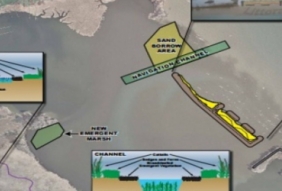
Posted on April 28, 2016
By Meaghan M. McDermott, Democrat & Chronicle
By this time next year, boaters could be able to do something that hasn’t been possible for at least a decade: easily access Lake Ontario from inside Braddock Bay.
That’s because the U.S. Army Corps of Engineers beginning in August will dredge out a long-clogged navigation channel and rebuild a barrier beach lost to storms in the 1970s that kept lake waves from washing excessive silt and sand into the bay.
It’s part of an $8 million initiative to restore fish and wildlife habitats to an ecologically important section of Lake Ontario.
“This is about restoring the ecosystem back to what it was,” said Bill Reilich, Greece town supervisor. “And it will have the added benefit of bringing in economic development to the area.”
The Army Corps on Tuesday celebrated completing the first phase of its Braddock Bay Ecosystem Restoration project with an open house at Braddock Bay Park on East Manitou Road.
Lt. Col. Karl Jansen said over the winter months, contractors working for the Army Corps excavated channels and potholes into the existing marshes and treated acres of invasive cattails in order to help boost native species and increase the diversity of the wetland habitat.
“Our plan is to wrap up the entire project later this year and then transfer oversight to the Town of Greece,” he said.
June Summers, president of the Genesee Valley Audubon Society, said the habitat restoration work was long overdue and thanked the federal and state governments, as well as town officials, for helping to ensure the project came to fruition.
U.S. Sen. Charles Schumer, D-New York, was a driving force behind securing money for the work from the U.S. Environmental Protection Agency.
“After decades of decline, I’m glad to report the multi-million federal investment to restore Braddock Bay back to the region’s premier wildlife conservation and recreational destination is in full swing,” he said in an emailed statement. “Since last August when I announced our successful push to convince the EPA to greenlight and fund this project, work crews have created new wetland habitats. Soon they will begin dredging to reconstruct the barrier beach that will not only protect the wetlands but enhance boating and recreation in Braddock Bay and rejuvenate the entire area.”
What led to the project?
In the early 1970s, storm surges blew out a protective spit that ran across the mouth of Braddock Bay. Since then, silt and sand carried by lake waves have plugged up the navigation channel and filled in parts of the bay. In the 1970s, bay depth ran 10 to 12 feet; today, parts are as shallow as 2 feet. Cattails have invaded, choking off vital spawning areas for northern pike and nesting areas for black tern, an endangered species in New York.
The bay is one of the largest coastal wetland ecosystems in the state, and is part of what’s known as the Rochester Embayment — lakefront between Bogus Point in Parma and Nine Mile Point in Webster — that is considered an “area of concern” by the EPA. It’s designated as such due to the degradation of its wildlife habitats and pollution. This project is intended to restore and protect 340 acres of coastal wetlands.
What work was done?
Jansen said contractors had hoped that cold winter temperatures would make it easier for them to get big equipment out into the bay in order to dig channels and potholes, but the mild weather required some creative thinking. Wesson Group LLC, of Johnstown, Fulton County, ended up bringing in an amphibious excavator from Louisiana to get the work done. All told, crews excavated some 11,700 linear feet of channels and dug 6.7 acres of potholes into the cattail dominant emergent marsh.
What’s next?
In August, crews will dig out a navigation channel that’s about 200 feet wide and at least eight feet deep. Sand from that endeavor will be set aside and used as Wesson Group constructs a barrier beach that includes a 1,675-foot continuous rubblemound breakwater, two 180-foot rubblemound groins, a three-acre headland beach and two 150-foot headland rubblemound breakwaters. The primary purpose of the beach will be to provide habitats and the overall breakwater and beach combination is designed to reduce wave energy in the bay and block sediment from entering the water body and becoming trapped within.
Plans also call for seeding and planting native species and treating invasive plant species.
Jansen said work should wrap up in November.
What about the boating?
It’s still going to be tough for boaters to get out of or into Braddock Bay for much of the upcoming season. But, Greece Supervisor Reilich said, the town is taking steps to make sure next year is much better. He said the town is seeking a new operator for its Braddock Bay Marina and has put out a request for proposals to find new management. Additionally, he said, the aim is to refurbish the 300-slip marina, likely by replacing the facility’s sagging, warped docks, improving restroom facilities there and perhaps adding a small supplies shop and restaurant.
“We really want to bring that marina up to its full potential,” he said.
Meanwhile, Greece resident Sue Dougherty, who enjoys kayaking and bird watching at the bay and nearby ponds, said she’s hopeful the project will bring the ecological benefits promised.
“I’ve really seen those cattails filling in over the past few years,” she said. “I think opening it back up is a good idea.”
READ FULL ARTICLE HERE





